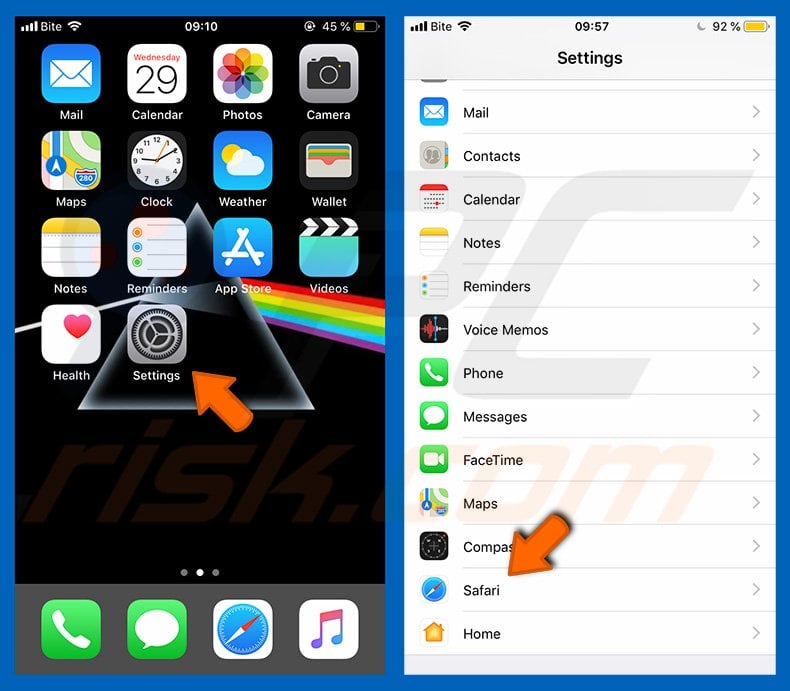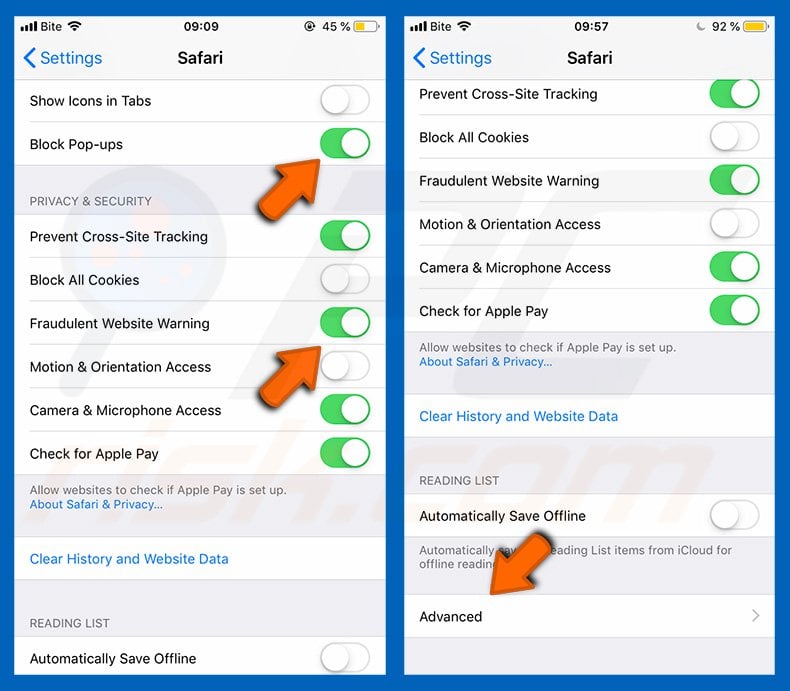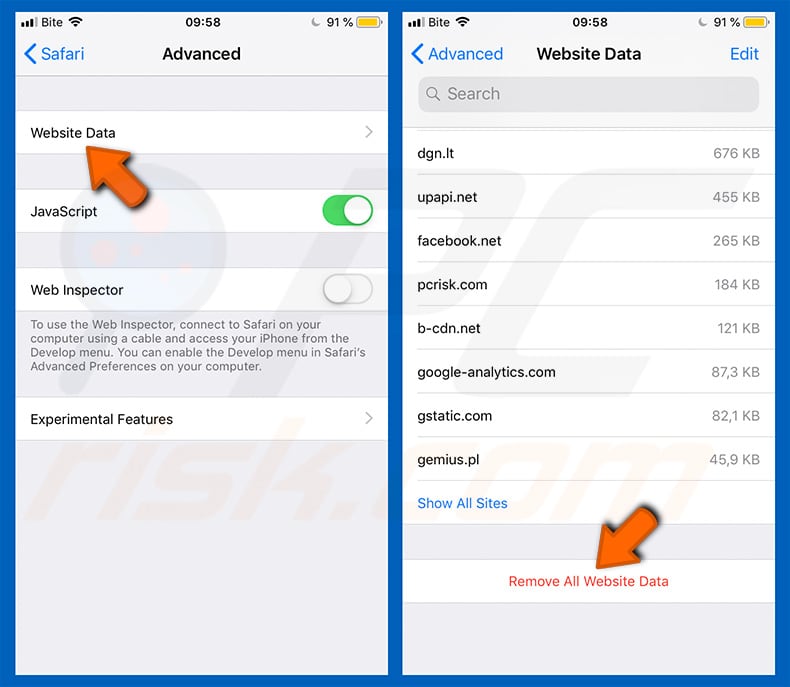Get free scan and check if your device is infected.
Remove it nowTo use full-featured product, you have to purchase a license for Combo Cleaner. Seven days free trial available. Combo Cleaner is owned and operated by RCS LT, the parent company of PCRisk.com.
What is vpnservice[.]me?
Usually, the main purpose of websites like vpnservice[.]me is to trick their visitors into downloading and installing some potentially unwanted applications (PUAs).
Most of them use scare tactics to promote PUAs, for example, they display fake virus or error messages claiming that visitors need to remove viruses, fix errors or solve other issues as soon as possible. Otherwise, a device will be damaged even more.
It is important to mention that it is very uncommon for pages like vpnservice[.]me to be visited by users on purpose. Most popular ways to promote such pages are through other shady websites, deceptive advertisements, or PUAs.
![vpnservice[.]me scam](/images/stories/screenshots202104/vpnservice-me-pop-up-scam-main.jpg)
Vpnservice[.]me masquerades as the official Apple website ("Apple Security Alert"), it shows a fake virus notification saying that Apple device (supposedly an iPhone) is heavily damaged/infected with a virus. This notification states that a detected virus has to be removed as soon as possible.
Otherwise, photos, videos, notes, and other may be permanently lost (deleted). In order to remove detected virus, message on the vpnservice[.]me page encourages visitors to click the "Remove Virus" and then install the downloaded application (supposedly a VPN client that blocks viruses).
Websites like this one should never be trusted as sources for downloading applications. They use deception to trick users into installing software, and the apps they promote may be browser hijackers, adware-type apps, or even malicious applications.
As mentioned in the first paragraph, one of the popular ways to promote websites like vpnservice[.]me is through potentially unwanted applications.
Typically, users download and install PAU unknowingly. It is common that apps of this type display advertisements (and) or gather various data as well. They serve coupons, pop-up ads, surveys, banners, and other advertisements.
As a rule, those ads conceal web content and are designed to advertise shady, potentially malicious pages. In some cases, those ads are designed to execute certain scripts that cause unwanted downloads or even installations. Therefore, it is never really safe to click those advertisements.
Examples of details that PUAs collect are Internet Protocol addresses, entered search queries, geolocations, addresses of visited websites, etc. Although, there are PUAs that target personal, sensitive data. T
he biggest issue is that gathered information could be sold to third parties (potentially cybercriminals), used for marketing purposes, or monetized using some other way.
| Name | vpnservice.me pop-up |
| Threat Type | Phishing, Scam, Mac malware, Mac virus |
| Fake Claim | Device is infected with a virus |
| Serving IP Address | 185.53.178.7 |
| Symptoms | Your Mac becomes slower than normal, you see unwanted pop-up ads, you are redirected to dubious websites. |
| Distribution methods | Deceptive pop-up ads, free software installers (bundling), fake Flash Player installers, torrent file downloads. |
| Damage | Internet browser tracking (potential privacy issues), display of unwanted ads, redirects to dubious websites, loss of private information. |
| Malware Removal (Windows) |
To eliminate possible malware infections, scan your computer with legitimate antivirus software. Our security researchers recommend using Combo Cleaner. Download Combo CleanerTo use full-featured product, you have to purchase a license for Combo Cleaner. 7 days free trial available. Combo Cleaner is owned and operated by RCS LT, the parent company of PCRisk.com. |
There are many websites like vpnservice[.]me on the Internet, here are a couple of examples: landingsecure[.]com, landoseseq[.]com, and security-protect[.]systems. Most of them are designed to look like official Apple websites.
Nevertheless, none of those pages are official, legitimate or trustworthy in any other way. It is worthwhile to mention that such pages could be used advertise legitimate applications. However, even legitimate apps should not be downloaded through deceptive pages.
How did potentially unwanted applications install on my computer?
It is common that potentially unwanted applications are bundled with other programs. It means that they are distributed by including them in downloaders, installers for other programs as extra offers.
This distribution method is quite successful because not all users decline unwanted offers before finishing downloads, installations.
Typically, bundled applications can be opted out using "Advanced", "Custom", "Manual" or other settings, or by unticking certain checkboxes that downloaders, installers for program that are bundled with PUAs have.
Another deceptive way to distribute PUAs is to design ads to execute certain scripts. Those ads cause unwanted downloads or even installations after they are clicked.
How to avoid installation of potentially unwanted applications?
It is recommended to use official and trustworthy websites (and direct links) as sources for downloading applications, files. Third-party downloaders (and installers), unofficial websites, Peer-to-Peer networks (e.g., torrent clients, eMule), can be used to distribute potentially malicious applications.
Also, it is advisable to check downloaders and installers for bundled applications. It is common that downloaders, installers that have "Advanced", "Custom" or other settings, or some checkboxes are used to distribute PUAs (are bundled with unwanted apps).
Additionally, it is recommended not to click on ads if they appear on shady web pages. Usually, those ads promote untrustworthy websites. Although, sometimes they can cause unwanted downloads, installations as well.
Any unwanted, suspicious extensions, plug-ins, or add-ons installed on a browser or programs of this kind installed on the operating system should be removed. If your computer is already infected with PUAs, we recommend running a scan with Combo Cleaner Antivirus for Windows to automatically eliminate them.
Tex in the website:
Apple Security Alert
Your Apple device system was heavily damaged with a virus.
If not resolved now, the damage could lead to erasing all the data (photos, videos, notes, data) that can be used against you by hackers. Please procees with the next steps to remove the virus completely.
Instruction how to save your device:Step 1: tap "Remove Virus"
Step 2: install VPN app that blocks the virus
Step 3: open VPN app and connect VPN - that will disable the virus completely.
Step 4: use VPN whenever you browse Internet to be 100% safe
Install VPN now to stop the virus!Remove Virus
To enable pop-up blocking, fraudulent website warnings, and remove web browsing data in mobile Apple devices, follow these steps:
First, go to "Settings", and then scroll down to find and tap "Safari".

Check if the "Block Pop-ups" and "Fraudulent Website Warning" toggles are enabled. If not, enable them immediately. Then, scroll down and tap "Advanced".

Tap "Website Data" and then "Remove All Website Data".

Instant automatic malware removal:
Manual threat removal might be a lengthy and complicated process that requires advanced IT skills. Combo Cleaner is a professional automatic malware removal tool that is recommended to get rid of malware. Download it by clicking the button below:
DOWNLOAD Combo CleanerBy downloading any software listed on this website you agree to our Privacy Policy and Terms of Use. To use full-featured product, you have to purchase a license for Combo Cleaner. 7 days free trial available. Combo Cleaner is owned and operated by RCS LT, the parent company of PCRisk.com.
Quick menu:
- What is vpnservice[.]me?
- STEP 1. Remove PUA related files and folders from OSX.
- STEP 2. Remove rogue extensions from Safari.
- STEP 3. Remove rogue add-ons from Google Chrome.
- STEP 4. Remove potentially unwanted plug-ins from Mozilla Firefox.
Video showing how to remove adware and browser hijackers from a Mac computer:
Potentially unwanted applications removal:
Remove potentially unwanted applications from your "Applications" folder:

Click the Finder icon. In the Finder window, select "Applications". In the applications folder, look for "MPlayerX", "NicePlayer", or other suspicious applications and drag them to the Trash. After removing the potentially unwanted application(s) that cause online ads, scan your Mac for any remaining unwanted components.
DOWNLOAD remover for malware infections
Combo Cleaner checks if your computer is infected with malware. To use full-featured product, you have to purchase a license for Combo Cleaner. 7 days free trial available. Combo Cleaner is owned and operated by RCS LT, the parent company of PCRisk.com.
Remove adware-related files and folders

Click the Finder icon, from the menu bar. Choose Go, and click Go to Folder...
 Check for adware generated files in the /Library/LaunchAgents/ folder:
Check for adware generated files in the /Library/LaunchAgents/ folder:

In the Go to Folder... bar, type: /Library/LaunchAgents/

In the "LaunchAgents" folder, look for any recently-added suspicious files and move them to the Trash. Examples of files generated by adware - "installmac.AppRemoval.plist", "myppes.download.plist", "mykotlerino.ltvbit.plist", "kuklorest.update.plist", etc. Adware commonly installs several files with the exact same string.
 Check for adware generated files in the ~/Library/Application Support/ folder:
Check for adware generated files in the ~/Library/Application Support/ folder:

In the Go to Folder... bar, type: ~/Library/Application Support/

In the "Application Support" folder, look for any recently-added suspicious folders. For example, "MplayerX" or "NicePlayer", and move these folders to the Trash.
 Check for adware generated files in the ~/Library/LaunchAgents/ folder:
Check for adware generated files in the ~/Library/LaunchAgents/ folder:

In the Go to Folder... bar, type: ~/Library/LaunchAgents/

In the "LaunchAgents" folder, look for any recently-added suspicious files and move them to the Trash. Examples of files generated by adware - "installmac.AppRemoval.plist", "myppes.download.plist", "mykotlerino.ltvbit.plist", "kuklorest.update.plist", etc. Adware commonly installs several files with the exact same string.
 Check for adware generated files in the /Library/LaunchDaemons/ folder:
Check for adware generated files in the /Library/LaunchDaemons/ folder:

In the "Go to Folder..." bar, type: /Library/LaunchDaemons/

In the "LaunchDaemons" folder, look for recently-added suspicious files. For example "com.aoudad.net-preferences.plist", "com.myppes.net-preferences.plist", "com.kuklorest.net-preferences.plist", "com.avickUpd.plist", etc., and move them to the Trash.
 Scan your Mac with Combo Cleaner:
Scan your Mac with Combo Cleaner:
If you have followed all the steps correctly, your Mac should be clean of infections. To ensure your system is not infected, run a scan with Combo Cleaner Antivirus. Download it HERE. After downloading the file, double click combocleaner.dmg installer. In the opened window, drag and drop the Combo Cleaner icon on top of the Applications icon. Now open your launchpad and click on the Combo Cleaner icon. Wait until Combo Cleaner updates its virus definition database and click the "Start Combo Scan" button.

Combo Cleaner will scan your Mac for malware infections. If the antivirus scan displays "no threats found" - this means that you can continue with the removal guide; otherwise, it's recommended to remove any found infections before continuing.

After removing files and folders generated by the adware, continue to remove rogue extensions from your Internet browsers.
Remove malicious extensions from Internet browsers
 Remove malicious Safari extensions:
Remove malicious Safari extensions:

Open the Safari browser, from the menu bar, select "Safari" and click "Preferences...".

In the preferences window, select "Extensions" and look for any recently-installed suspicious extensions. When located, click the "Uninstall" button next to it/them. Note that you can safely uninstall all extensions from your Safari browser - none are crucial for regular browser operation.
- If you continue to have problems with browser redirects and unwanted advertisements - Reset Safari.
 Remove malicious extensions from Google Chrome:
Remove malicious extensions from Google Chrome:

Click the Chrome menu icon ![]() (at the top right corner of Google Chrome), select "More Tools" and click "Extensions". Locate all recently-installed suspicious extensions, select these entries and click "Remove".
(at the top right corner of Google Chrome), select "More Tools" and click "Extensions". Locate all recently-installed suspicious extensions, select these entries and click "Remove".

- If you continue to have problems with browser redirects and unwanted advertisements - Reset Google Chrome.
 Remove malicious extensions from Mozilla Firefox:
Remove malicious extensions from Mozilla Firefox:

Click the Firefox menu ![]() (at the top right corner of the main window) and select "Add-ons and themes". Click "Extensions", in the opened window locate all recently-installed suspicious extensions, click on the three dots and then click "Remove".
(at the top right corner of the main window) and select "Add-ons and themes". Click "Extensions", in the opened window locate all recently-installed suspicious extensions, click on the three dots and then click "Remove".

- If you continue to have problems with browser redirects and unwanted advertisements - Reset Mozilla Firefox.
Share:

Tomas Meskauskas
Expert security researcher, professional malware analyst
I am passionate about computer security and technology. I have an experience of over 10 years working in various companies related to computer technical issue solving and Internet security. I have been working as an author and editor for pcrisk.com since 2010. Follow me on Twitter and LinkedIn to stay informed about the latest online security threats.
PCrisk security portal is brought by a company RCS LT.
Joined forces of security researchers help educate computer users about the latest online security threats. More information about the company RCS LT.
Our malware removal guides are free. However, if you want to support us you can send us a donation.
DonatePCrisk security portal is brought by a company RCS LT.
Joined forces of security researchers help educate computer users about the latest online security threats. More information about the company RCS LT.
Our malware removal guides are free. However, if you want to support us you can send us a donation.
Donate
▼ Show Discussion